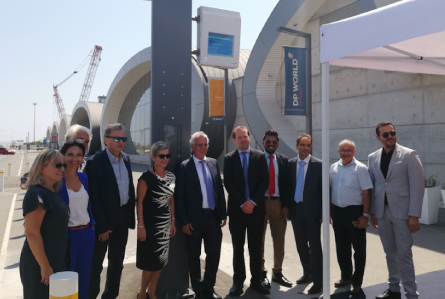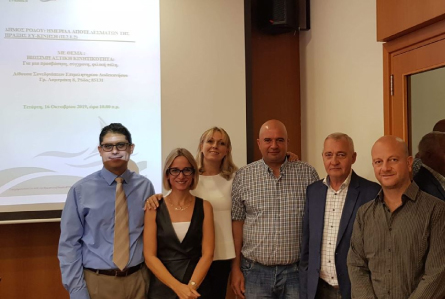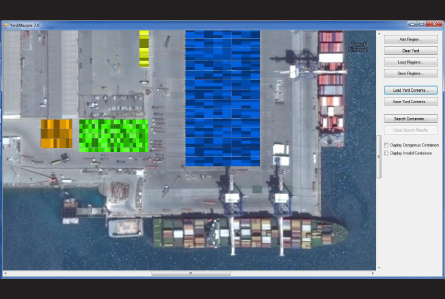INTRA Lab
Profile
Collaborate with us
We work with businesses and organisations of all sizes and sectors. Click here to find out how our research can help you through consultancy, licensing and technology transfer, collaborative research and more.
Overview
The Intelligent Networks and Transportation Systems - INTRA Lab is engaged in state of the art research, on topics pertinent to the application of advanced control theoretic and optimization methods towards adding intelligence in complex networks such as computer networks, transportation networks, power networks and nanonetworks. Novel automation techniques on home and industrial applications through the use of Programmable Logic Controllers (PLCs) and microcontrollers are also investigated especially at the teaching level.
In particular, the topics of ongoing research are outlined below:
- Nano Networks
Nano networks is a relatively new networking paradigm where nodes at the nanoscale, with limited processing and communication capabilities communicate, to form nano-networks with applications ranging from medical sensing to material formation. Members of the group have been involved in activities pertinent to two nano-networking paradigms: Molecular Communications and Metasurfaces.
- Molecular Communications
Original work on this topic was relying on theoretical models to develop probabilistic information dissemination schemes for molecular networks i.e. networks involving biological nodes communicating using mechanisms such as diffusion or molecular motors. Communication modelling and analysis of MIMO systems and gradient based routing were also investigated. However, motivated by the lack of testbeds to validate the theoretical findings in this field, we are currently coordinating the Phero-MolCom project funded by RPF which aims at developing a new testbed using yeast cells.
- Metasurfaces
Members of the group have also been recently involved in the design of fault tolerant routing protocols for a novel nano-network structure embedded in a new hardware platform called the HyperSurface, that can host metasurface functionalities described in software. The HyperSurface essentially merges existing metasurfaces, i.e thin film planar, artificial structures, with nanonetworks, acting as a reconfigurable metasurface whose properties can be changed via a software interface. These state of the art technologies have inspired ground-breaking applications to a range of research topics, such as electromagnetic invisibility of objects (cloaking), radiation absorption, filtering of light and sound as well as efficient antennas for sensors and implantable communication devices. In our work we consider the hypersurface paradigm to realize next generation wireless communication technologies in 6G and vehicular networks. The dynamic nature of the systems under consideration calls for autonomous operation and current efforts focus on developing control based algorithms for such stand-alone operation to be evaluated on a practical testbed made available to us through our participation in the FETOPEN action Visorsurf.
Beyond the original work on fault tolerant routing and workload characterization our current research efforts focus on:
- Utilizing formal adaptive control methods (multivariable extremum seeking controllers) and reinforcement learning for online reconfiguration of the metasurface controller states towards autonomous operation
- Investigating the challenges and performance gains from the adoption of metasurfaces in data centers.
- Investigating the adoption of metasurfaces for cooperative perception in vehicular networks to support autonomous cooperative driving applications.
- Security and Privacy in the Internet of Things
More and more devices are integrated in the Internet of Things. These devices gather significant amount of private information pertinent to a user and while, in some cases it helps in improving the life style of an individual, in others it raises major privacy concerns. This trade-off between utility and privacy is highly dependent upon the devices in consideration and as the utility of the generated data increases, the privacy of an individual decreases. Members of the group and collaborators have formulated a utility-privacy trade-off that enables a user to make appliance specific decisions as to how much data can be shared. The smart metering application has been considered as the test case scenario for the proposed approach and simulation results have indicated its effectiveness. Beyond that, members of the group have considered the use of blockchain technology in safeguarding IoT systems against adversarial attacks. Blockchains have been utilized to secure the join procedure in LoRaWAN devices in IoTs, and also to protect to protect them against Botnet attacks. In our more recent work, the control over blockchains concept has been proposed, where blockchains are utilized to secure both the data storage and control procedures in process control systems in Industry 4.0 using smart contracts. The feasibility and effectiveness of the concept has been demonstrated using the benchmark Tennessee Eastman Process.
Finally, in earlier work members of the group considered the node criticality problem which is of outmost importance in the resiliency of critical networked infrastructures. Critical node discovery plays a vital role in assessing the vulnerability of a network to an abrupt change, such as an adversarial attack or human intervention and can be used to enhance network security. In earlier work we have proposed a new metric to characterize the criticality of a node in an arbitrary network which we refer to as the Combined Banzhaf & Diversity Index. We have also addressed the problem via an optimization based framework and have utilized spectral partitioning concepts to derive a suboptimal metric which has been shown to outperform previous proposals.
- Vehicular Ad Hoc Networks
Vehicular Ad Hoc Networks constitute an emerging network paradigm, which poses significant design challenges. Our ongoing research pertinent to these networks has focused on the development, evaluation and analysis of information dissemination schemes. We have developed a speed adaptive probabilistic flooding scheme which can facilitate the fast and reliable dissemination of emergency warning messages in case of an unexpected event such as a traffic accident. Extensions of this work are based on simple models of multiple lane roads leading to designs with provable performance. We have also developed an adaptive information hovering scheme which can maintain the emergency information in a confined area for a specific amount of time. The developed information hovering protocol has been successfully used in combination with wireless broadcasting for data dissemination offloading and performance improvement in vehicular networks. Our current research work deals with the adoption of Reconfigurable Intelligent Metasurfaces in developing more efficient information dissemination solutions which can assist in realizing next generation automated driving schemes, as for example coordinated driving on non-signalized intersections.
- Smart Grid
Beyond exploring the privacy vs utility tradeoff in Smart Grid IoT systems, group members have been engaged at preliminary investigations on aggregator based demand response systems to match supply and demand. A crucial aspect of this is power load modelling, and online parameter identification techniques from control theory have been utilized to address this challenge. Our current investigations deal with a blockchain implementation of the theoretical algorithms developed earlier in order to guard the system against adversarial attacks. Beyond that the group has participated in a research proposal with Japanese partners to extend these findings in the presence of power flow coloring, a novel concept with provides flexibility in smart grid management and control.
- Green Communications
As the networking infrastructures become increasingly integrated leading to the Internet of Things whose size is expected to be humongous, energy efficiency of network operations has become an increasingly important topic. This is even more important in sensor networks with scarce energy resources and energy harvesting capability. Members of the group have formulated the energy management problem as a queue control problem where the transmission is regulated in order to guide the energy level within the battery at a desired reference level. A notable feature of the protocol is that it incorporates predictions of the energy to be harvested using the proposed ASIM model. The stability of the scheme has been established analytically and the effect of integrating it in congestion control schemes is currently being investigated from both a practical and an analytical perspective.
- Congestion Control in Computer Networks
TCP constitutes a cornerstone of the current Internet, largely responsible for its effective operation and efficient use in everyday life. Despite its profound success, there are strong indications that TCP will perform poorly as the Internet continues to evolve. Members of the group have developed new intelligent congestion protocols which are able to adapt to changes in the operating conditions to achieve stable and robust performance. The adaptation is achieved by means of online parameter identification techniques from adaptive control theory. Particular instantiations of the proposed controllers have been shown analytically to be stable in arbitrary networks.
Our main equipment/facilities available
Matlab is being used for general modelling and simulation of dynamical systems. The VISSIM software is utilized to model major parts of the transportation network and the ns-3 software is being used to model the networking aspects of the systems under consideration. In terms of hardware, the team is using the equipment in the control lab (linear system, torsional system, magnetic levitation system, gyroscope), a set of SIEMENS PLCs enhanced with a wireless communication unit and a radar based sensor which can obtain real time traffic measurements.
Research Projects Experience
Members of the group have participated in a number of projects in activities pertinent to communications (VISORSURF, SEACORN, AGILE) and transportation systems (EY-KINISIS, TRAFFICNET, EM-VANETS, BUSSIM, PRODROMOS). These projects have been funded by both the European Union and local funding agencies (Cyprus Research Promotion Foundation). In these research activities members of the group have collaborated with institutions such as the University of Southern California, the University of Cyprus, UPC Spain, City University London, National University of Sciences and Technology, University of Bahrain and the Ministry of Transportation and Works.
| Position | Name | Department | Research Domain |
|---|---|---|---|
| Lead researcher | Dr Marios Lestas | Electrical, Computer Engineering and Informatics (DECI) | Control Systems, Computer Networks |
| Unit Member | Mr Ehizogie Isoboye Emoyon-Iredia | DECI | Metasurface Assisted Cooperative Driving |
| Unit Member | Mr Nikolaos Ntetsikas | DECI | Molecular Communications |
| Unit Member | Mr Awais Bin Asif | DECI | Cascaded Metasurfaces |
| Start Year | Project Title | Lead Partner/ Assignee | Funding from | Project Website |
|---|---|---|---|---|
| 2022 | A Yeast Pheromone Testbed for Molecular Communications | Frederick Research Center | RIF | N/A |
| 2020 | Blockchain for SMEs | CIVIC | Erasmus+ | https://bct4smes.eu/partners |
| 2020 | Artificial Intelligence for Power Theft and Transformer Health | EMTECH | EYDE-ETAK | N/A |
| 2017 | Public Transport Integrated Telematics System for Sustainable Urban Mobility | Rhodes Municipality | INTERREG | N/A |






